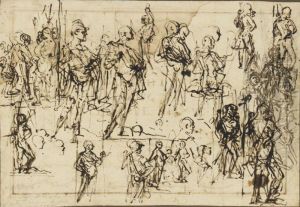Giovan Antonio Fasolo Paintings
Giovan Antonio Fasolo was an Italian painter of the Renaissance period, born in 1530 in Cologna Veneta, a small town in the Veneto region of Italy. He is often associated with the Venetian school of painting, although his work also reflects the influence of the Mannerist style that was spreading through Italy during his lifetime.
Fasolo's early training is not well-documented, but it is believed that he may have been a pupil of Giovanni Battista Zelotti and an associate of Paolo Veronese, both of whom were prominent Venetian painters. His style is characterized by a robust use of color, a flair for decorative detail, and a certain theatricality in composition, all of which suggest the influence of his contemporaries in the Venetian artistic circle.
The majority of Fasolo's known works are frescoes in villas and churches in the Veneto region. One of his most notable projects was the fresco decoration of the Villa Caldogno in Caldogno, which was designed by the renowned Renaissance architect Andrea Palladio. Fasolo's frescoes in the villa are significant examples of the integration of architecture and painted decoration that was a hallmark of the Palladian villa aesthetic.
Fasolo's career was relatively short, as he died prematurely in 1572 at the age of 42. Despite his early death, he left behind a body of work that contributes to our understanding of the transition between the High Renaissance and Mannerist styles in Northern Italy. His works are not as widely recognized as those of his more famous peers, but they nonetheless offer valuable insights into the cultural and artistic milieu of the Veneto region during the 16th century.
